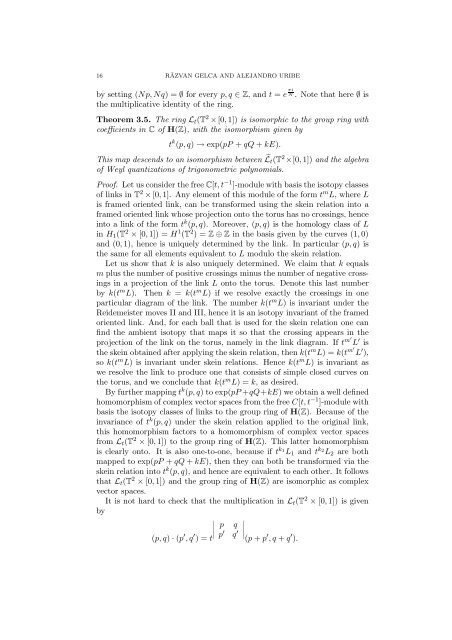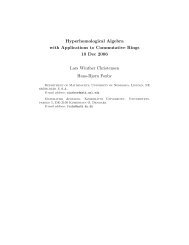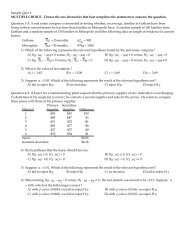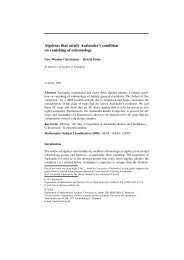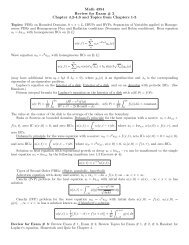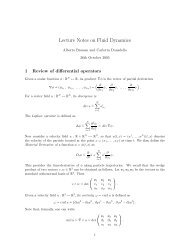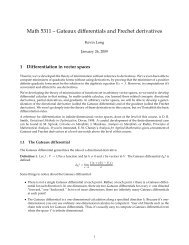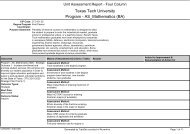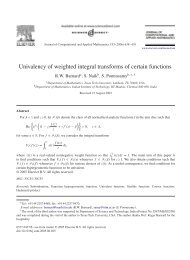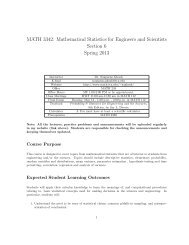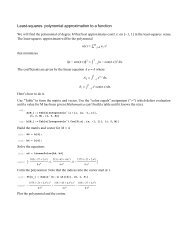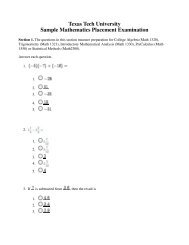QUANTUM MECHANICS AND NON-ABELIAN THETA FUNCTIONS ...
QUANTUM MECHANICS AND NON-ABELIAN THETA FUNCTIONS ...
QUANTUM MECHANICS AND NON-ABELIAN THETA FUNCTIONS ...
You also want an ePaper? Increase the reach of your titles
YUMPU automatically turns print PDFs into web optimized ePapers that Google loves.
16RĂZVAN GELCA <strong>AND</strong> ALEJ<strong>AND</strong>RO URIBEby setting (Np,Nq) = ∅ for every p,q ∈ Z, and t = e πiN . Note that here ∅ isthe multiplicative identity of the ring.Theorem 3.5. The ring L t (T 2 ×[0,1]) is isomorphic to the group ring withcoefficients in C of H(Z), with the isomorphism given byt k (p,q) → exp(pP + qQ + kE).This map descends to an isomorphism between ˜L t (T 2 ×[0,1]) and the algebraof Weyl quantizations of trigonometric polynomials.Proof. Let us consider the free C[t,t −1 ]-module with basis the isotopy classesof links in T 2 × [0,1]. Any element of this module of the form t m L, where Lis framed oriented link, can be transformed using the skein relation into aframed oriented link whose projection onto the torus has no crossings, henceinto a link of the form t k (p,q). Moreover, (p,q) is the homology class of Lin H 1 (T 2 × [0,1]) = H 1 (T 2 ) = Z ⊕ Z in the basis given by the curves (1,0)and (0,1), hence is uniquely determined by the link. In particular (p,q) isthe same for all elements equivalent to L modulo the skein relation.Let us show that k is also uniquely determined. We claim that k equalsm plus the number of positive crossings minus the number of negative crossingsin a projection of the link L onto the torus. Denote this last numberby k(t m L). Then k = k(t m L) if we resolve exactly the crossings in oneparticular diagram of the link. The number k(t m L) is invariant under theReidemeister moves II and III, hence it is an isotopy invariant of the framedoriented link. And, for each ball that is used for the skein relation one canfind the ambient isotopy that maps it so that the crossing appears in theprojection of the link on the torus, namely in the link diagram. If t m′ L ′ isthe skein obtained after applying the skein relation, then k(t m L) = k(t m′ L ′ ),so k(t m L) is invariant under skein relations. Hence k(t m L) is invariant aswe resolve the link to produce one that consists of simple closed curves onthe torus, and we conclude that k(t m L) = k, as desired.By further mapping t k (p,q) to exp(pP +qQ+kE) we obtain a well definedhomomorphism of complex vector spaces from the free C[t,t −1 ]-module withbasis the isotopy classes of links to the group ring of H(Z). Because of theinvariance of t k (p,q) under the skein relation applied to the original link,this homomorphism factors to a homomorphism of complex vector spacesfrom L t (T 2 × [0,1]) to the group ring of H(Z). This latter homomorphismis clearly onto. It is also one-to-one, because if t k 1L 1 and t k 2L 2 are bothmapped to exp(pP + qQ + kE), then they can both be transformed via theskein relation into t k (p,q), and hence are equivalent to each other. It followsthat L t (T 2 × [0,1]) and the group ring of H(Z) are isomorphic as complexvector spaces.It is not hard to check that the multiplication in L t (T 2 × [0,1]) is givenby(p,q) · (p ′ ,q ′ ) = t˛p qp ′ q˛˛˛˛˛(p ′ + p ′ ,q + q ′ ).


